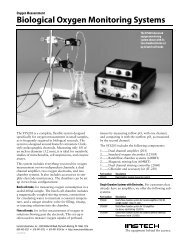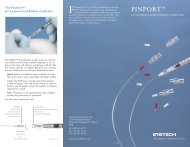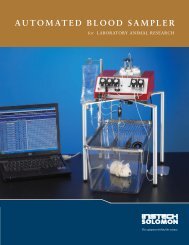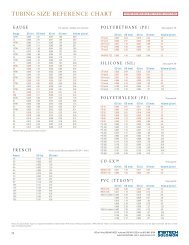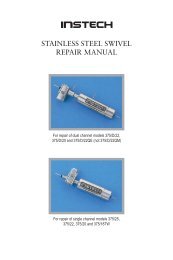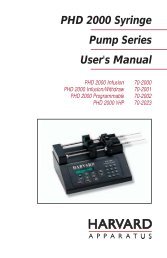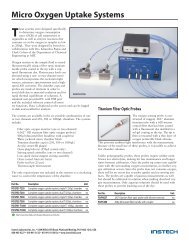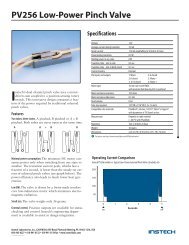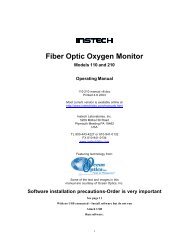dissolved oxygen monitoring system - Instech Laboratories, Inc.
dissolved oxygen monitoring system - Instech Laboratories, Inc.
dissolved oxygen monitoring system - Instech Laboratories, Inc.
Create successful ePaper yourself
Turn your PDF publications into a flip-book with our unique Google optimized e-Paper software.
Symptom<br />
Response to <strong>oxygen</strong> good,<br />
but signal level has gradually<br />
increased over a period of<br />
weeks<br />
Response to <strong>oxygen</strong> good,<br />
but signal level has gradually<br />
decreased over a period of<br />
weeks<br />
Potential problem<br />
Platinum cathode surface may have<br />
become roughened, increasing the<br />
active surface area and therefore the<br />
current<br />
Platinum cathode has become<br />
coated or poisoned<br />
Treatment<br />
Renovate electrode tip.<br />
Renovate electrode tip.<br />
Appendix B: System Theory<br />
This <strong>dissolved</strong> <strong>oxygen</strong> measuring <strong>system</strong> is<br />
designed around a style of polarographic<br />
electrode developed by Dr. Leland Clark.<br />
When a potential of about 0.7V is applied<br />
between the anode and the cathode, <strong>dissolved</strong><br />
gaseous <strong>oxygen</strong> is reduced at the platinum<br />
cathode. This produces a current and consumes<br />
the <strong>oxygen</strong> in the immediate vicinity of the<br />
exposed platinum cathode. Oxygen in the sample<br />
volume diffuses through the membrane to the<br />
<strong>oxygen</strong>-poor region between the membrane and<br />
the electrode. When a steady-state is reached<br />
(which usually happens in less than 4 seconds),<br />
the electrode current is proportional to the rate of<br />
arrival of <strong>oxygen</strong> molecules at the cathode, which<br />
is in turn proportional to the concentration of<br />
<strong>oxygen</strong> outside the membrane.<br />
The <strong>oxygen</strong> amplifier does two things: (1) it<br />
generates the electrode biasing potential and (2) it<br />
measures the electrode current, usually only a few<br />
nanoamps, and converts it to a voltage.<br />
The electrode is quite sensitive to temperature<br />
changes as temperature affects the speed of the<br />
chemical reaction, the ease of diffusion across the<br />
membrane and the ambient <strong>oxygen</strong> concentration<br />
of the sample solution. Electrode readings will<br />
increase by about 4% for a temperature increase<br />
of 1°C.<br />
In order to make an accurate measurement of<br />
<strong>oxygen</strong> levels in the entire sample volume, the<br />
<strong>oxygen</strong> around the outside of the membrane must<br />
be replaced. If the sample is not adequately<br />
stirred when working in batch cell mode, or if the<br />
flow rate is too low when working in flow cell<br />
mode, a concentration gradient will be set up<br />
outside the membrane and the rate of arrival of<br />
<strong>oxygen</strong> at the electrode will decrease. Slight fluid<br />
velocity changes will produce a “motion artifact”.<br />
The type of material used as a membrane also<br />
critically affects the performance of the <strong>system</strong>.<br />
We have found that 0.001” to 0.0009” thick<br />
polyethylene, which is readily available from<br />
normal sandwich bags, works best. Membranes<br />
that are more <strong>oxygen</strong> permeable, such as TFE<br />
Teflon or silicone, may be required for<br />
experiments at low temperatures or when a<br />
response rate faster than 4 seconds is desired.<br />
However, these materials will cause a greater<br />
motion artifact because the concentration<br />
gradient extends further into the bulk solution.<br />
TFE Teflon will also stretch and thin over time,<br />
causing the initial amplifier calibration to become<br />
incorrect. FEP Teflon usually works well, but is<br />
too stiff to wrap around the small electrode tip.<br />
Saran is not sufficiently permeable to <strong>oxygen</strong> to<br />
be useful as a membrane.<br />
13






